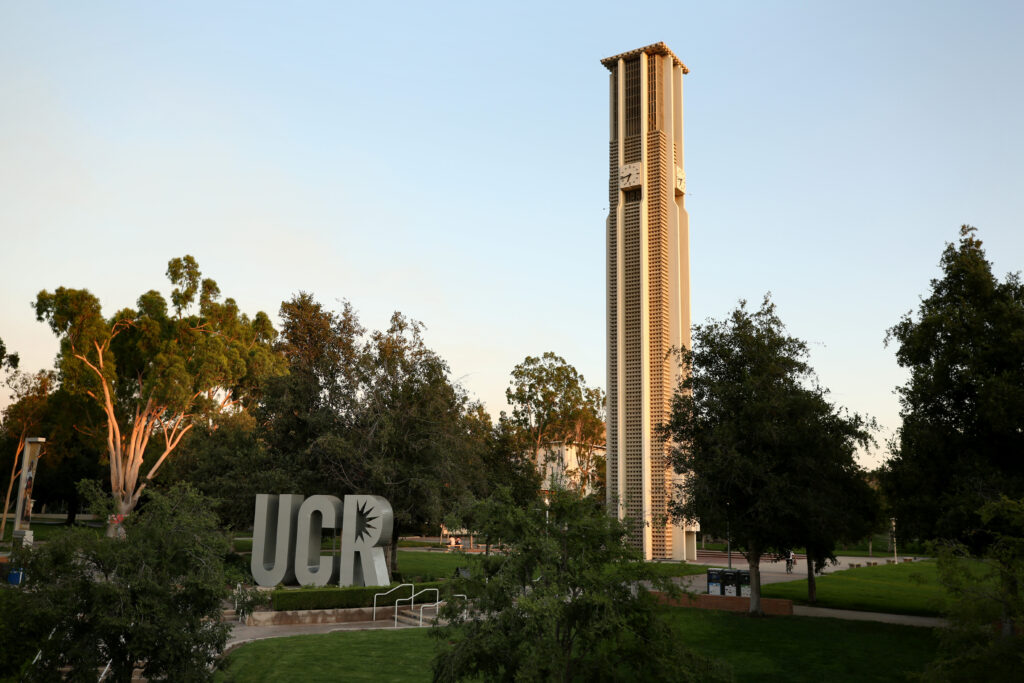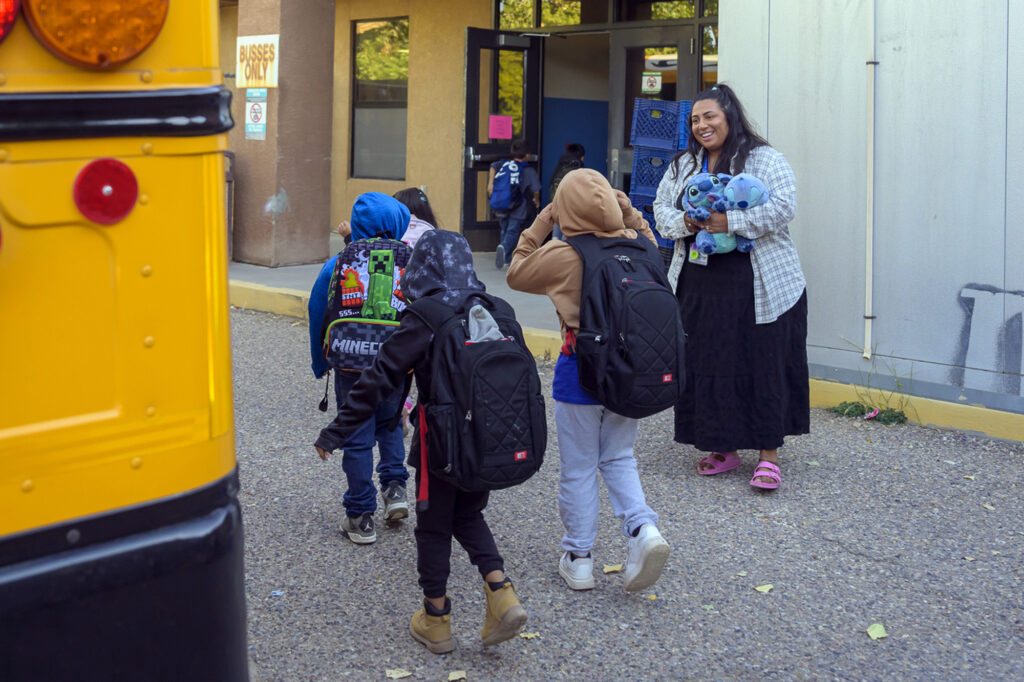
The bell tower and UCR sign on the campus of UC Riverside.
Credit: UC Riverside / Stan Lim
Sitting across from UC Riverside Chancellor Kim Wilcox inside a conference room on the campus, Samia Alkam presented him with her Palestinian identification card.
A doctoral student at Riverside, Alkam’s identification limits her to the West Bank in Palestine. She explained to Wilcox that even though she also has American citizenship, Israel bars West Bank residents like her from traveling to places such as Tel Aviv and Jerusalem without a special permit or visa.
That was relevant to the matter at hand, as Wilcox and Alkam deliberated over what to do about a summer abroad program offered by Riverside’s School of Business. As part of the program, students visit Jerusalem and Tel Aviv.
Days earlier, pro-Palestinian student protesters at Riverside erected an encampment and demanded administrators cut ties with Israel. Alkam, the lead negotiator for students, implored Wilcox to discontinue the abroad program, arguing it violated the university’s anti-discrimination policy because not all students could participate regardless of their country of national origin.
“They have students who are on campus who can’t participate in that program just because of their birth status,” Alkam told EdSource later. “It was really important for me to illustrate that in a very visual way for them.”
According to the U.S. State Department, American citizens who are also residents of the West Bank need a visa or permit to enter Israel. Other Americans can use their passport to visit for business or tourism purposes without a visa.
Focusing on the study abroad program reflected the students’ strategy to try winning tangible changes at Riverside even if they couldn’t get the campus to divest financially from companies tied to Israel amid its war on Gaza, a key demand of protesters at campuses across the country.
Aided by their faculty adviser, Christine Victorino, who previously was Wilcox’s chief of staff, the students came to the negotiating table with what they believed were reasonable asks. A spokesperson for Riverside said nobody on Wilcox’s staff was available for an interview, but directed EdSource to Victorino. With an intimate knowledge of how the chancellor’s office operates, she advised the students on making requests that had a chance to be successful.
On the second night of negotiations, Alkam and other negotiators met with Wilcox for seven hours inside the conference room at Riverside’s Hinderaker Hall. By the next morning, they had their deal, which included terminating the abroad program.
Rather than single out the program in Israel, Wilcox discontinued all of the business school’s global programs, which also operate in Oxford, Cuba, Vietnam, Brazil, China, Egypt and Jordan. Wilcox’s office declined to comment for this story, but according to his office’s website, officials learned “through our dialogue” during the negotiations that the abroad program was not “consistent with university policies.”
As part of the deal, Wilcox also agreed to consider whether campus vendors should be permitted to sell Sabra hummus products. Students at Riverside and other campuses across the country for years have targeted Sabra. One of Sabra’s owners is the Strauss Group, an Israeli food company that has long been scrutinized by pro-Palestinian activists over its support for the Israeli Defense Forces.
While not committing to divestment, Wilcox said he would start a process to review the Riverside campus endowment’s investments. That was the most Wilcox could do because Riverside doesn’t manage its own endowment; instead, UC’s systemwide investments office does. Under the agreement, Riverside will explore the possibility of managing the endowment itself.
Wilcox made the concessions after two days of negotiations. In exchange, student protesters agreed to end their encampment just four days after they initially erected it. The campus also avoided the violence between pro-Palistinian protesters and Israeli supporters that had occurred earlier that week at UCLA, which negotiators believed was a motivating factor for Wilcox to get a deal.
As college protesters across California have demanded their campuses cut ties with Israel, few have gotten any formal concessions. Across most campuses, negotiations have either stalled or ended altogether. Several campuses have even resorted to calling in police to forcibly disband encampments and arrest students.
But at Riverside, the spring quarter is ending with little fanfare. A stark contrast to several other University of California campuses, Riverside has remained peaceful in the weeks since the agreement, which remains one of the few deals reached by campus protesters and administrators across California. Others to make deals include UC Berkeley and Sacramento State.
Of UC’s seven campuses on the quarter calendar where classes continued into this month, Riverside was also the only one where academic workers did not strike. Graduate assistants and other student workers did strike at the six other campuses, arguing that UC violated union members’ rights by retaliating against them for participating in pro-Palestinian protests.
“I knew that I would look more revolutionary if we stood firm and we kept our encampment up for longer, and we started getting arrests and getting the same press coverage as other universities,” Alkam said. “But to me, it was more important to get the material changes that we did get.”
Avoiding violence
Two nights prior to the main negotiating session at Riverside, counterdemonstrators at UCLA violently attacked the pro-Palestinian encampment there, injuring student protesters and sending some to the hospital.
Wilcox, students believed, did not want to risk a similar situation unfolding at his campus, which prides itself on being one of the most ethnically diverse and welcoming universities, including for Middle Eastern students. Riverside was the first in the nation to have a Middle Eastern Student Center, according to its website.
“Their whole image is centered around them being progressive and them being diverse,” Alkam said. “They felt so much pressure to not look like UCLA.”
Victorino, the faculty adviser for the students, agreed. She said in an interview that “as a former administrator, the main concern” was the possibility of violence.
It was that kind of insight into the chancellor’s office and how it operates that Victorino was able to provide to the students. Before last year, she had spent seven years as Wilcox’s chief of staff. In that role, she helped Wilcox navigate several major controversies and challenges, including the Covid-19 pandemic and a restructuring of the campus police department.
Victorino, now a professor of practice in Riverside’s school of education, only got involved in the encampment negotiations after being approached by Alkam. Alkam was previously Victorino’s teaching assistant and asked her to be the students’ adviser. Unsure if she wanted to involve herself in the negotiations, Victorino sought advice from Wilcox. He encouraged her to accept the role, so she did.
She helped the students understand what would and wouldn’t be possible. Victorino, for example, explained to the students that Riverside’s endowment is managed by the systemwide office, giving Wilcox little control over the campus investments. With that information, the students compromised on their original demand calling for Riverside to immediately divest its endowment funds from any companies related to Israel.
Victorino even told them how Wilcox might react to certain requests. “We kind of just role-played what the meeting would be like,” Victorino said.
Elsewhere, negotiations stall
More than a month since their deal, Riverside remains one of the few campuses where protesters and officials found common ground.
At other campuses, like UC Santa Cruz, negotiations have gone south. About two weeks ago at that campus, after weeks of stalled negotiations, Chancellor Cynthia Larive called in police who disbanded an encampment there and arrested students. Police also have dismantled encampments and arrested protesters at campuses such as UC Irvine, UC San Diego and UCLA, where a second encampment was erected.
Complicating the negotiations is the governance structure of the 10-campus University of California and 23-campus California State University systems. Both systems are governed by centralized boards and systemwide president’s and chancellor’s offices, limiting the autonomy of campus-level administrators.
CSU system officials publicly scolded one campus president, Sonoma State President Mike Lee, for agreeing to seek “divestment strategies” and to not engage in study abroad programs in Israel. Lee was placed on administrative leave and, two days later, said he would retire.
“The chancellor and presidents have been in constant contact during protest activities on campuses with the intent that decisions at the university level are made in consultation with the Chancellor’s Office,” CSU spokesperson Amy Bentley-Smith said in a statement to EdSource.
A UC spokesperson declined to comment. But UC said in a statement in April that it “opposes calls for boycott against and divestment from Israel.”
At Santa Cruz, protesters initially set up their encampment about six weeks ago, but it has been more than a month since administrators have negotiated with them. Student protesters last submitted a set of demands to Larive’s staff on May 10, but “there’s been no official communication between us and the administration since then,” said Jamie Hindery, an undergraduate student at the campus and a spokesperson for the protesters.
A Santa Cruz spokesperson did not return a request for comment on this story.
Larive in a statement said the encampment was unlawful and a “dangerous blockade from the campus entrance.” She added that the encampment “disrupted campus operations and threatened safety, including delaying access of emergency vehicles.”
Protesters, however, dispute that. “Copious eyewitness testimony, backed by photos and video evidence, contradict this account,” the campus chapter of Students for Justice in Palestine said in a statement responding to Larive.
Hindery said the police activity eliminated any chance of negotiations resuming. It’s a reality he believes is true across most UC campuses, where finals are happening this week and commencement ceremonies are scheduled for this weekend. “People don’t want to attend their own graduations. Students feel betrayed and unsafe,” he said. “I would be very surprised if campus-level negotiations were to restart any time soon.”
Meanwhile, at Riverside, Alkam credited administrators for choosing “peace and safety” and compromising with the students.
“That’s something that the other campuses should have learned from, and they definitely didn’t,” she said.












)
)